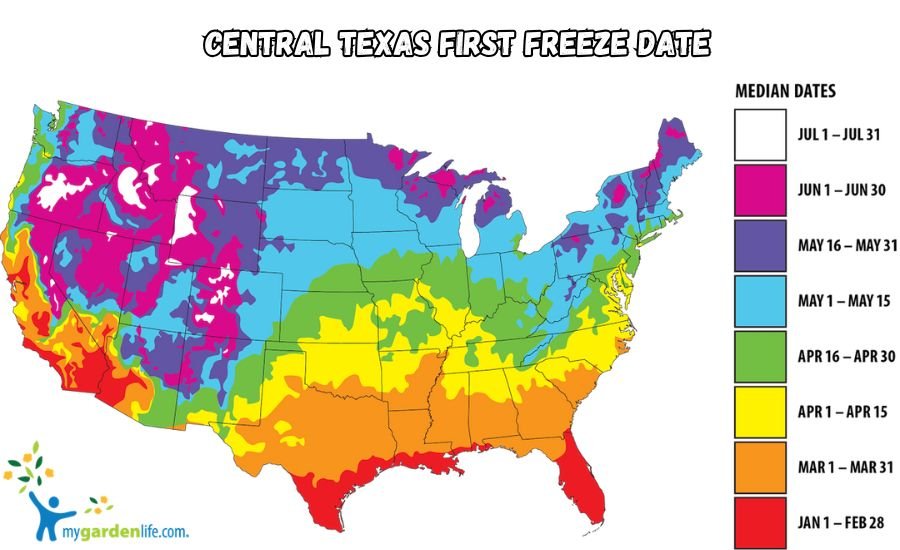The Central Texas first freeze date is an important seasonal milestone for the region, signaling the shift from warm fall weather to the colder temperatures of winter. This date can vary from year to year, but it holds significant meaning for gardeners, farmers, and homeowners. In this article, we will explore when the Central Texas first freeze date typically occurs, factors influencing it, and what this freeze means for the local community.
What Is the First Freeze Date?

The Central Texas first freeze date refers to the first occurrence of temperatures dipping below 32°F (0°C) in a given year. This is when the region experiences its first frost or freeze, which can have a significant impact on local crops, vegetation, and daily life. Understanding when this date happens allows people to prepare for cold weather, protect sensitive plants, and plan for upcoming winter activities.
Factors Influencing the Central Texas First Freeze Date
Several factors determine when the Central Texas first freeze date occurs, including:
- Geographic Location – Central Texas encompasses a range of elevations, and the first freeze date can vary depending on whether you are in a valley, on a hill, or in a more urban area.
- Weather Patterns – The year-to-year variations in weather patterns play a big role in determining the Central Texas first freeze date. Global weather patterns, such as El Niño or La Niña, can alter the timing of the freeze.
- Climate Change – Climate change may also affect the Central Texas first freeze date, with the possibility of warmer temperatures delaying the arrival of the first freeze.
Historical Trends in Central Texas First Freeze Dates
To better understand when the Central Texas first freeze date might occur in any given year, it’s useful to look at historical patterns. Over the past few decades, the first freeze in Central Texas has typically occurred between late November and early December, but there are exceptions.
Average First Freeze Date for Central Texas
On average, the Central Texas first freeze date occurs around November 15. However, depending on the year, it could come earlier or later. For instance, in some years, the freeze could occur as early as mid-October, while in others, it may not happen until December. Historically, Central Texas has experienced both early and late freezes, which shows the variability of weather patterns.
| Feature | Description |
| Average Date | Typically occurs between late November and early December. |
| Temperature | Temperatures drop below 32°F (0°C), marking the first freeze. |
| Impact on Crops | Can damage sensitive crops, requiring protection strategies. |
| Climate Influence | Affected by geographic location, weather patterns, and climate change. |
| Effect on Homeowners | Requires winter preparation, such as protecting pipes and checking heating systems. |
| Preparation for Farmers | Farmers protect crops with covers or early harvesting to prevent frost damage. |
| Weather Forecasting | Meteorologists use weather patterns to predict the first freeze date. |
| Local Economic Impact | Freezes can affect agricultural output, businesses, and the local economy, especially in early freezes. |
| Wildlife Impact | Wildlife adjusts by growing thicker fur, migrating, or hibernating as temperatures drop. |
| Annual Variability | The freeze date can vary each year due to weather patterns and climate changes. |
What Happens After the First Freeze in Central Texas?

Once the Central Texas first freeze date arrives, there are immediate effects on local agriculture and home life:
Read More: Discover-gmainl-a-quick-guide
- Impact on Crops – Farmers must prepare for the first freeze to protect their crops. Certain vegetables, fruits, and plants are more vulnerable to freezing temperatures, and early freezes can result in crop loss.
- Winter Preparations – Homeowners and businesses must start preparing for winter after the Central Texas first freeze date. This includes insulating pipes, checking heating systems, and making sure vehicles are ready for colder weather.
Protecting Plants After the Central Texas First Freeze Date
For gardeners, the Central Texas first freeze date is a critical moment. Many plants are sensitive to frost and need protection when temperatures drop. To safeguard your garden after the Central Texas first freeze date, consider using frost blankets, bringing in potted plants, or covering delicate plants with mulch. It’s important to act quickly to prevent damage from freezing temperatures.
The Role of the First Freeze in Local Wildlife
While humans and plants feel the effects of the Central Texas first freeze date, wildlife also experiences changes. Many animals begin to prepare for winter by growing thicker fur, migrating, or hibernating. The Central Texas first freeze date marks a transition in local ecosystems, as animals adjust to the colder environment.
Farmers’ Guide to Preparing for the First Freeze
Farmers in Central Texas are accustomed to the arrival of the Central Texas first freeze date, and they have strategies to protect crops. This includes covering crops with protective sheets, using irrigation to shield plants from frost, and harvesting sensitive crops before the freeze hits. By understanding the timing of the Central Texas first freeze date, farmers can take the necessary steps to prevent crop damage.
How the First Freeze Affects Central Texas Economy
The Central Texas first freeze date can have a ripple effect on the local economy. A freeze can affect the agricultural sector, as well as industries that rely on crops, such as food processing. The early arrival of the Central Texas first freeze date can also disrupt local businesses that rely on mild weather for their operations, such as construction or landscaping services.
Looking at Weather Forecasting for the First Freeze in Central Texas
Accurately predicting the Central Texas first freeze date requires sophisticated weather forecasting. Meteorologists track temperature patterns and monitor atmospheric conditions to predict when temperatures will dip below freezing. As the first freeze approaches, the community prepares, and businesses can make decisions based on these predictions.
Tips for Homeowners: Preparing for the Central Texas First Freeze Date
Homeowners can take several steps to prepare for the Central Texas first freeze date:
- Check Heating Systems – Before the Central Texas first freeze date, ensure your heating system is functioning properly.
- Protect Outdoor Plumbing – Pipes are vulnerable to freezing temperatures, so wrap outdoor pipes in insulation to prevent them from bursting after the freeze.
- Prepare Your Lawn and Garden – As the Central Texas first freeze date approaches, take steps to protect your plants from frost damage.
Does the First Freeze Date Always Come on Time?

The Central Texas first freeze date is not set in stone. While patterns may suggest that the first freeze happens around November 15, it can vary depending on the year. Weather anomalies or shifts in climate conditions can cause the freeze to come earlier or later than expected. For this reason, it’s important to monitor weather forecasts closely as the Central Texas first freeze date approaches.
The Central Texas First Freeze Date and Its Impact on Local Events
Certain local events may also be impacted by the Central Texas first freeze date. For example, festivals, outdoor concerts, and holiday markets may be affected if an early freeze occurs. Planning for weather changes is essential when hosting outdoor events in the region during fall and winter.
Impact on Heating Bills After the First Freeze in Central Texas
Once the Central Texas first freeze date hits, homeowners may notice an increase in their heating bills. The colder weather leads to higher energy consumption, and people need to keep their homes warm. It’s advisable to prepare for this change by budgeting for higher heating costs after the Central Texas first freeze date.
Conclusion
Understanding the Central Texas first freeze date is important for everyone in the area. It helps farmers, gardeners, and homeowners prepare for cold weather. The first freeze usually happens between late November and early December, but it can be different each year. This freeze can affect plants, crops, and even wildlife, so it’s good to know when it might happen. By preparing early, people can protect their plants, homes, and outdoor equipment from the cold.
After the Central Texas first freeze date, things start to change. Farmers may have to cover their crops or harvest them early to keep them safe from the frost. Homeowners might need to check their heating systems and make sure their pipes are safe from freezing. Even wildlife gets ready by growing thicker fur or moving to warmer places. Knowing about the Central Texas first freeze date helps everyone stay ready for the cold and enjoy the winter season safely.
Do You Know: Smithfield-okta-a-security-solution
FAQs
When does the first freeze typically occur in Central Texas?
The first freeze in Central Texas usually happens between late November and early December, but it can vary each year.
What temperature defines the first freeze in Central Texas?
The first freeze occurs when temperatures drop below 32°F (0°C), marking the onset of freezing conditions.
How can I protect my plants from the first freeze?
To protect plants, cover them with frost blankets, bring in potted plants, or apply a thick layer of mulch around the base.
Does the first freeze date change every year?
Yes, the Central Texas first freeze date can vary each year depending on weather patterns and climate conditions.
How does the first freeze affect local farmers?
Farmers need to protect their crops from frost by using covers, irrigation, or harvesting early to avoid damage from the freeze.






